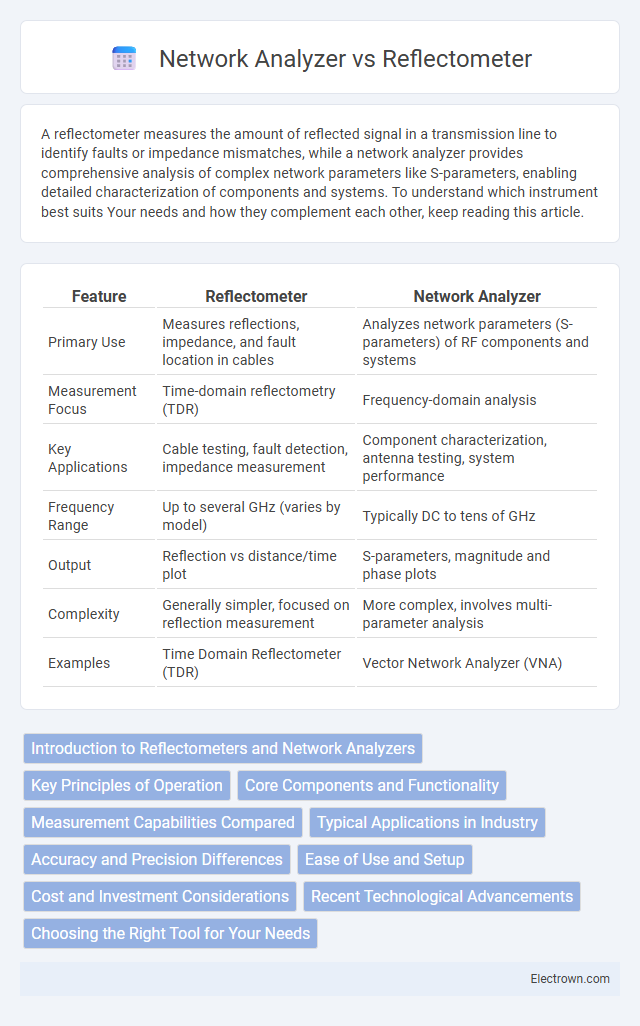A reflectometer measures the amount of reflected signal in a transmission line to identify faults or impedance mismatches, while a network analyzer provides comprehensive analysis of complex network parameters like S-parameters, enabling detailed characterization of components and systems. To understand which instrument best suits Your needs and how they complement each other, keep reading this article.
Table of Comparison
| Feature | Reflectometer | Network Analyzer |
|---|---|---|
| Primary Use | Measures reflections, impedance, and fault location in cables | Analyzes network parameters (S-parameters) of RF components and systems |
| Measurement Focus | Time-domain reflectometry (TDR) | Frequency-domain analysis |
| Key Applications | Cable testing, fault detection, impedance measurement | Component characterization, antenna testing, system performance |
| Frequency Range | Up to several GHz (varies by model) | Typically DC to tens of GHz |
| Output | Reflection vs distance/time plot | S-parameters, magnitude and phase plots |
| Complexity | Generally simpler, focused on reflection measurement | More complex, involves multi-parameter analysis |
| Examples | Time Domain Reflectometer (TDR) | Vector Network Analyzer (VNA) |
Introduction to Reflectometers and Network Analyzers
Reflectometers measure the reflection coefficient of electrical signals by sending a known signal into a device and analyzing the reflected waves, primarily used for fault detection and cable testing. Network analyzers characterize the complete network parameters, such as S-parameters, providing comprehensive insight into device performance across a frequency range. These tools are essential in RF and microwave engineering, with reflectometers focusing on impedance mismatches and network analyzers delivering detailed frequency response and transmission data.
Key Principles of Operation
A reflectometer measures the reflected signal amplitude and phase to determine impedance mismatches along a transmission line, using time-domain reflectometry (TDR) principles. A network analyzer characterizes the complex scattering parameters (S-parameters) by measuring the amplitude and phase of transmitted and reflected signals across a range of frequencies, providing comprehensive frequency-domain analysis. Reflectometers emphasize localized fault detection through time-domain reflection, while network analyzers offer detailed frequency response and network characterization.
Core Components and Functionality
Reflectometers primarily consist of a directional coupler, signal source, and detector, enabling measurement of reflected signals to identify impedance mismatches along transmission lines. Network analyzers integrate signal generators, receivers, and mixers to measure both amplitude and phase, facilitating comprehensive characterization of complex impedance and S-parameters across multiple ports. Core functionality of reflectometers centers on return loss and reflection coefficient detection, while network analyzers provide vector network analysis with detailed frequency response and network topology insights.
Measurement Capabilities Compared
Reflectometers excel in measuring reflected signals to determine impedance mismatches and cable faults, providing precise return loss and reflection coefficient data. Network analyzers offer comprehensive measurement capabilities, including magnitude and phase of S-parameters across a wide frequency range, enabling detailed characterization of complex RF components and systems. While reflectometers specialize in localized fault detection, network analyzers deliver broader frequency response analysis and multi-port parameter measurements.
Typical Applications in Industry
Reflectometers are commonly used in telecommunications and cable manufacturing to detect faults and measure cable length by analyzing signal reflections. Network analyzers find typical applications in RF and microwave engineering, wireless communications, and antenna design, where they accurately measure complex impedance, gain, and signal integrity. Your choice depends on whether you need to assess transmission line performance or characterize network components.
Accuracy and Precision Differences
Reflectometers offer high accuracy in measuring reflection coefficients, making them ideal for identifying impedance mismatches with minimal signal distortion. Network analyzers provide superior precision by delivering detailed complex impedance and phase information across a broad frequency range, enabling comprehensive characterization of network parameters. Your choice depends on whether you prioritize measurement accuracy for specific reflections or precision in comprehensive network analysis.
Ease of Use and Setup
Reflectometers offer straightforward setup and are typically easier to operate due to their specialized function in measuring reflected signals and identifying faults in transmission lines quickly. Network analyzers provide comprehensive characterization of network parameters but require more complex calibration and a steeper learning curve due to their advanced measurement capabilities. Users seeking simplicity and rapid deployment often prefer reflectometers, while detailed network analysis necessitates the sophisticated setup of network analyzers.
Cost and Investment Considerations
Reflectometers generally have a lower initial cost compared to network analyzers, making them a more budget-friendly option for basic cable and antenna testing. Network analyzers, while more expensive, offer comprehensive measurement capabilities that justify the higher investment for advanced signal analysis and troubleshooting. Your decision should balance these cost differences with the complexity of testing requirements to ensure optimal value.
Recent Technological Advancements
Recent technological advancements have significantly enhanced the precision and functionality of both reflectometers and network analyzers. Modern reflectometers now incorporate improved time-domain reflectometry (TDR) techniques, offering faster fault detection and higher spatial resolution in cable testing. Your network analyzer benefits from advanced signal processing algorithms and broader frequency ranges, enabling more accurate impedance and vector measurements essential for complex RF system design.
Choosing the Right Tool for Your Needs
Choosing between a Reflectometer and a Network Analyzer depends on your specific measurement requirements and application complexity. A Reflectometer, such as a Time Domain Reflectometer (TDR), specializes in pinpointing faults and impedance mismatches along cables, making it ideal for cable testing and troubleshooting. In contrast, a Network Analyzer offers comprehensive frequency response analysis, measuring complex parameters like S-parameters, which makes it more suitable for detailed component characterization and system-level network evaluation.
Reflectometer vs Network Analyzer Infographic

 electrown.com
electrown.com